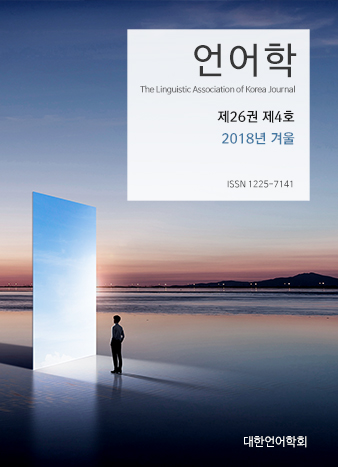대한언어학회 전자저널

-
L1 Interference in Koreans' Perception of Released Word-final Stops in English
-
Perceptual Similarity between English and Korean: Evidence from Online Adaptation
-
A Study on the Definite Article in English Based on the Rasch Model
-
Phonetic Resurrection from Ellipsis Sites: A Case from Pseudo-gapping
-
A Study of the Content Validity of Reading Comprehension Tests in NMET II
-
Labeling, Cartography, and the Left-periphery of Korean Clauses
26권 4호 (2018년 12월)
- 고유명사와 정관사 공기에 대한 한국인 영어학습자들의 습득 실태 분석
-
최정아 & 이예식
Pages : 245-266
Abstract
Keywords
# 정관사(definite article) # 고유명사(proper nouns) # 습득(acquisition) # 친숙도(familiarity) # 한국인 영어학습자(Korean EFL learners) # 상관관계(correlation)
References
- 이예식, 진현석. (2013). 한국 고등학교 1학년의 영어 중간언어 실태 분석: 명시적 및 묵시적 구문지식을 중심으로. 언어학, 21(3), 339-361.
- 최정아, 이예식. (2017). 영어 정관사-고유명사 공기현상과 문법교육. 중등교육연구, 65(4), 1019-1047.
- Abbott, B. (2001). Definiteness and proper names: Some bad news for the description theory. Journal of Semantics, 19, 191-201.
- Abbott, B. (2009). Reference, Oxford University Press.
- Bannard, C., & Matthews, D. (2008). Stored word sequences in language learning: The effect of familiarity on children's repetition of four word combinations. Psychological Science, 19, 241-248.
- Beck, M. (1997). Regular verbs, past tense and frequency: tracking down a potential source of NS/ NNS competence differences. Second Language Research, 13, 93-115.
- Birdsong, D., & Flege, J. E. (2001). Regular-irregular dissociation in L2 acquisition of English morphology. In BUCLD 25, Proceedings of the 25th Annual Boston University Conference on Language Development (pp. 123-132). Boston, MA: Cascadilla Press.
- Burnard, L., & Aston, G. (1998). The BNC handbook: Exploring the British national corpus with Sara. Edinburgh University Press.
- Connine, C. M., Mullennix, J. W., Shernoff, E., & Yelen, J. (1990). Word familiarity and frequency in visual and auditory word recognition. Journal of Experimental Psychology: Learning, Memory, and Cognition, 16, 1084-1096.
- Cziko, G. A. (1986). Testing the language bioprogram hypothesis: A review of children’s acquisition of articles. Language, 62(4), 878-898.
- Elley, W. (1989) Vocabulary acquisition from listening to stories. Reading Research Quarterly, 24, 174-87.
- Ellis, N. C., & Schmidt, R. (1998). Rules or associations in the acquisition of morphology? The frequency by regularity interaction in human ad PDP learning of morphosyntax. Language and Cognitive Processes, 13, 307-336.
- Ellis, N. C. (2002). Frequency effects in language processing: A review with implications for theories of implicit and explicit language acquisition. Studies in Second Language Acquisition, 24, 143-188.
- Gass, S. M., & Mackey, A. (2002). Frequency Effects and Second Language Acquisition. Studies in Second Language Acquisition, 24, 249-260.
- Hamayan, E., & Tucker. R. (1980). Language input in the bilingual classroom and its relations to second language achievement. TESOL Quarterly, 14, 453-468.
- Hatch, E. S., & Wagner G. (1976). Explaining sequence and variation in second language acquisition. Language Learning(Special issue), 4, 39-47.
- Ionin, T., Ko, H., & Wexler, K. (2004). Article semantics in L2 acquisition: The role of specificity. Language Acquisition, 12(1), 3-69.
- Larsen-Freeman, D. (1976a). Teacher speech as input to the ESL learner. University of California Working Papers in TESL 10, 45-49.
- Larsen-Freeman, D. (1976b). An explanation for the morpheme acquisition order of second language learners. Language Learning, 26, 125-134.
- Lightbown, P. (1983). Exploring relationships between developmental and instructional sequences in L2 acquisition. In H. Seliger & M. Long (Eds.), Classroom-oriented Research in Second Language Acquisition (pp. 217-243). Rowley, MA: Newbury House.
- Löbner, S. (1985). Definites. Journal of Semantics, 4, 279-326.
- Long, M. H. (1981). Input, interaction and second language acquisition. In H. Winitz (Ed.), Native Language and Foreign Language Acquisition (sic). Annals of the New York Academy of Sciences, 379, 259-278.
- Long, M., & Sato, C. (1984). Methodological issues in interlanguage studies: an interactionist perspective. In A. Davies, C. Criper, & A. Howatt (Eds.), Interlanguage (pp. 253-279). Edinburgh: Edinburgh University Press.
- Matushansky, O. (2006). Why rose is the rose: on the use of definite articles in proper names. Empirical Issues in Syntax and Linguistics and Philosophy, 26, 287-350.
- Nation, P. (2001). Learning vocabulary in another language. Cambridge: Cambridge University Press.
- Palmberg, R. (1987). Patterns of vocabulary development in foreign-language learners. Studies in Second Language Acquisition, 9, 201-220.
- Quirk, R., Greenbaum, S., Leech, G., & Savartvik, J. (1985). A comprehensive grammar of the English language. London: Longman.
- Rapp, R. (2005). On the relationship between word frequency and word familarity. In B. Fisseni, H.-C. Schmitz, B. Schroder, & P. Wagner (Eds.), Sprachtechnologie, Mobile Kommunikation and Linguistische Ressourcen. Beitrage zur GLDV-Tagung 2005 in Bonn (pp. 249-263). Frankfurt: Peter Lang.
- Roberts. C. (2003). Uniqueness in definite noun phrases. Linguistics and Philosophy, 26, 287-350.
- Russell, B. (1905). On denoting. Mind, 66, 479-493.
- Snow, C., & Hoefnagel-Hohle, M. (1982). School age second language learners’ access to simplified linguistic input. Language Learning, 32, 411-430.
- Tanaka-Ishili, K., & Terada, H. (2011). Word familiarity and frequency. Studia Linguistica, 65, 96-116.
- Van Langendonck, W., & Van de Velde, M. (2009). The functions of (In)definiteness markers with proper names. In W. Ahrens, S. Embleton, & A. Lapierre (Eds.), Names in multi-lingual, multi-cultural and multi-ethnic contact. Proceedings of the 23rd International Congress of Onomastic Sciences (pp. 1005-1011). York University, Toronto, Canada.